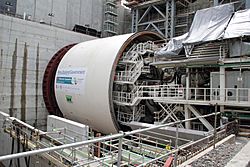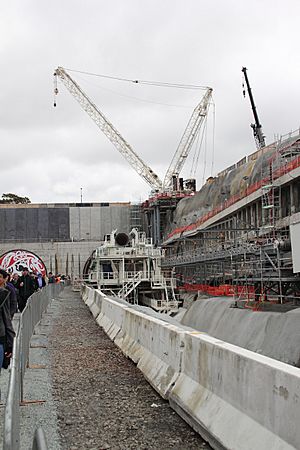Waterview Tunnel facts for kids
The Waterview Tunnel is a huge road tunnel in Auckland, New Zealand. It's actually two tunnels side-by-side! At 2,400 meters long, it's the longest road tunnel in New Zealand. This tunnel helps connect major highways, State Highway 20 and State Highway 16. It has three lanes for cars in each direction. The tunnel is a key part of Auckland's Western Ring Route, a big motorway system that goes around the city.
 |
|
| Alice the Tunnel Boring Machine during the construction of the Waterview Tunnel | |
| Overview | |
|---|---|
| Location | Auckland, New Zealand |
| Status | Opened 2 July 2017 |
| Route | |
| Start | Point Chevalier |
| End | Mount Roskill |
| Operation | |
| Operator | NZ Transport Agency |
| Traffic | Motor vehicles |
| Character | Motorway |
| Toll | Not tolled |
| Technical | |
| Construction | 2011–2017 |
| Length | 7,874 feet (2,400.0 m) |
| Number of lanes | 6 (3 per tunnel) |
| Operating speed | 80 km/h (50 mph) |
Contents
Why the Waterview Tunnel Was Built
The Waterview Tunnel was built to finish the Western Ring Route. This route gives drivers a second main road through Auckland. If you're traveling from the north to the south (or the other way around), you can now avoid the busy city center. This also means less traffic on SH1 and the Auckland Harbour Bridge. The tunnel also makes it easier to get directly from the city to Auckland Airport. Before, drivers had to use smaller local roads.
Who Built the Tunnel?
The Waterview Tunnel was a huge project. It was built by a group of companies working together called the Well-Connected Alliance. This team included the NZ Transport Agency, Fletcher Construction, McConnell Dowell, Parsons Brinckerhoff, Beca Infrastructure, Tonkin+Taylor, and Obayashi Corporation. Other companies, Wilson Tunnelling and SICE, also helped out.
How the Tunnel Was Built
Building the Waterview Tunnel was a massive job. It involved making special concrete parts and using a giant machine.
Making Concrete Rings
A special factory was built in East Tamaki, Auckland just to make the concrete rings for the tunnels. They needed 2,414 rings in total! Each ring is two meters wide and 14 meters across. They are made from 10 concrete pieces, and each piece weighs 10.5 tonnes. Some rejected pieces were used to create a memorial in Te Kauwhata.
Alice the Tunnel Boring Machine
A special machine called an Earth Pressure Balance tunnel boring machine (TBM) was built for the Waterview Tunnel. It was made in China. This TBM was 14 meters wide and 97 meters long. It could dig at a speed of 80mm per minute. The machine arrived in Auckland in July 2013. Digging started in November 2013.
People nicknamed the TBM "Alice" after a public vote. Alice was the 11th largest machine of its kind in the world. Alice dug the two tunnels by going back and forth. She dug up to 45 meters deep to go under hard rock, water, and even sea level. The first tunnel was finished in September 2014. Alice finished the second tunnel in October 2015. She was then taken apart and sent back to Germany.
Building Cross-Passages
While Alice was digging, workers also started building cross-passages in early 2015. These are 16 short tunnels that connect the two main tunnels. They are about 11 meters long each. These passages are important for safety. If there's an emergency, people can use them to get from one tunnel to the other. They also hold equipment for running the tunnels. All the cross-passages were finished by December 2015.
Tunnel Safety Features
The Waterview Tunnels have many features to keep everyone safe. These include:
- Electronic message boards
- Speed cameras
- Public address systems
- Radio sound systems
- CCTV cameras
- Ventilation and fire sprinkler systems
Special operators watch the traffic using computers. Emergency exits and phones are placed every 150 meters in each tunnel. There are also systems to stop vehicles that are too tall from entering. Signals on the ramps help control how many cars enter the tunnel.
Tunnel Closures and Detours
Sometimes, the tunnels need to close for maintenance. This usually happens at night, between 10pm and 5am. When the tunnels are closed, drivers use a detour route. This route goes through Great North Road, Blockhouse Bay Road, Tiverton Road, New Windsor Road, and Maioro Street.
Vehicles Not Allowed in the Tunnel
Some vehicles are not allowed to use the Waterview Tunnels. These include:
- Vehicles carrying dangerous goods (like chemicals)
- Vehicles taller than 4.3 meters
- Vehicles with loads that are not covered
These vehicles must use the detour route instead.
When the Tunnel Opened
The Waterview Tunnel was expected to open in April 2017. However, there was a delay in March 2017. This was because of problems with the sprinkler system and computer software. On June 11, 2017, it was announced that the tunnel would open in early July. The tunnels officially opened on July 2, 2017. The first cars drove through at 12:47 AM, led by police cars.
Te Haerenga Hou (Artwork)
Auckland artist Graham Tipene created a special artwork for the tunnel entrance. It is called Te Haerenga Hou, which means "New Journey."
The artwork shows a journey from the Manukau Harbour. It passes by volcanoes like Te Ara Pūeru /Māngere, Te Hōpua (Gloucester Park), Maungakiekie (One Tree Hill), and Puketāpapa (Mt Roskill). It ends at the feet of Ōwairaka (Mt Albert). This path follows the tunnels underground. The artwork also tells the story of two lovers, Tamaireia and Hinemairangi. Their story is said to be linked to how the region's volcanoes were formed.


